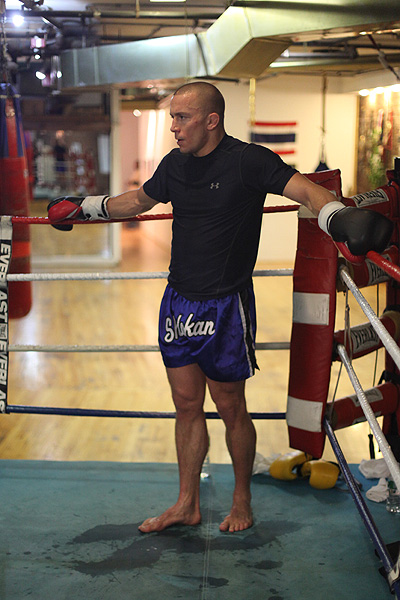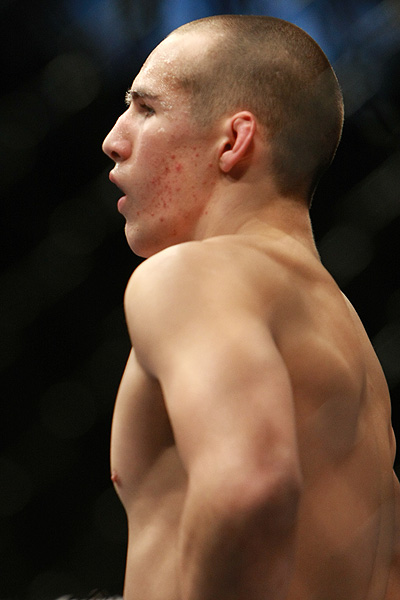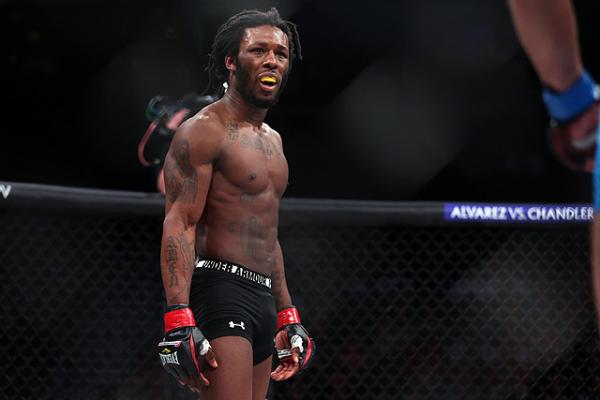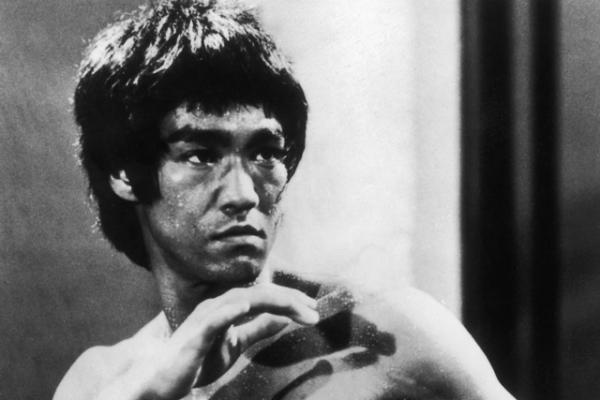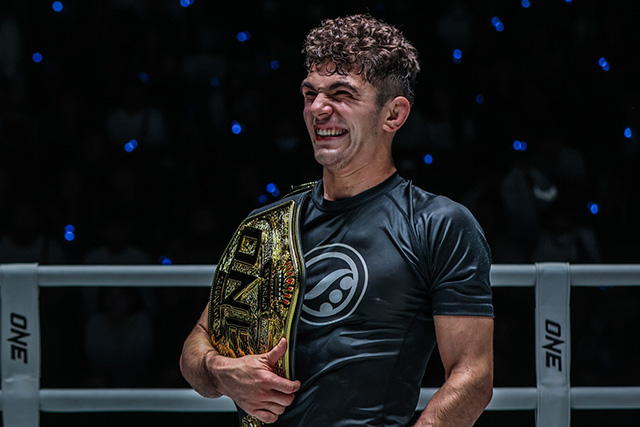One-on-One with Firas Zahabi: Part 1
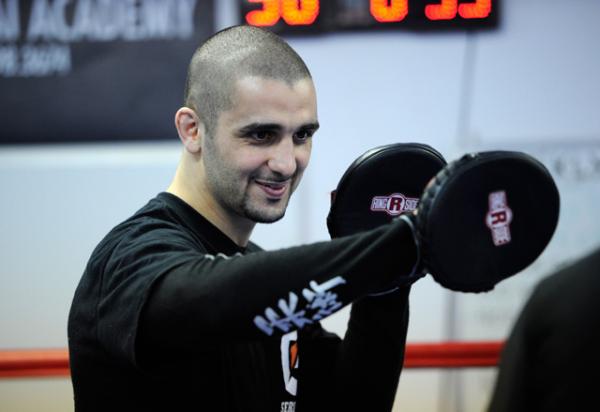
Firas Zahabi pays attention to the details. | Photo: Lucas
Oleniuk
MONTREAL -- Home of some of the finest fighters to have ever strapped on a pair of four-ounce gloves, it is an unassuming-looking facility in the suburbs of Canada’s second-largest city. On the inside, however, it houses a wealth of experience, knowledge and some of the most forward-thinking coaching and training practices in modern-day MMA.
Firas Zahabi is in large part what makes Tristar Gym a special place. His approach, uncommon in a sport that is often rife with emotion and ingrained practices, is exceptionally analytical, in-depth and innovative. In part one of this exclusive interview, Zihabi discusses his background, game planning, training some of the world’s best fighters and his philosophies:
Advertisement
Related: One-on-One with Firas Zahabi -- Part 2
Sherdog.com: How did you get into coaching in the first place?
Zahabi: I saw Royce Gracie like everybody else, and I was shocked. I was in awe that this little guy can beat up these bigger, muscular guys. I was desperately looking for a gym, and there was no gym; by chance, I found a place that was hosting a tournament and I went to the tournament; I watched the tournament. I saw some guys who were doing really good and asked them where they trained. That’s how I found Angelo Exeherakos, a Brazilian jiu-jitsu purple belt who was training under Renzo Gracie and driving down to New York, and I was stuck to his hip ever since. He had a severe neck injury, he had a business he had to take care of and he couldn’t do it anymore, so me, Georges [St. Pierre] and David Loiseau were really adamant about training and he positioned me as the trainer temporarily until he came back and things quieted down for him. Things never did quiet down for him. His business grew more and more, so eventually I just took over, naturally and organically. There was no pre-made plan. It just happened this way.
Sherdog.com: What were you doing before you got really into training?
Zahabi: I was competing as an amateur. I won two Canadian titles in muay Thai and I won two provincial gold medals in freestyle [wrestling], one silver, and I won many grappling tournaments. I was just competing, like GSP, training in all the arts and just having fun. I did a lot of boxing matches, as well, and I was getting my degree at the same time in university. I was a 145er and I never thought there’d be a UFC category for 145 [pounds]; like, I saw what the guys were making -- Georges made $6,000/$6,000 to beat Karo [Parisyan] -- so I was doing it for fun. After I got my degree, I said to myself, “I’m going to try and earn a living teaching jiu-jitsu and MMA and boxing because it’s what I love, and if it doesn’t work out I’ll go into law like I originally planned, you know, as a safety net.” Lo and behold, the UFC exploded, GSP exploded, Tristar Gym exploded and all these explosions were happening, and this is where we’re at today.
Sherdog.com: What did you study in school?
Zahabi: I have a bachelor’s [degree] in philosophy, and I think it helped me immensely in my efforts. The thing is, people say, “You’re a young coach,” but I grew up with the sport. There’s nobody doing it 15 years longer than me. When the sport came to the west, I was right on board, day one. Who has more experience than me? I’m younger, but we have the same level of experience. As soon as the sport was exposed to the world, I was right on board. I should say I was a little late: I started in 2000.
Sherdog.com: That still seems like forever in the grand context of things, right?
Zahabi: Of course, I was here in the first 10 years. If you think about it, a lot of guys had a karate background, a boxing background. I had no background at all, so I was able to adapt. I think it was both a good thing and a bad thing. I didn’t have a base. I had to learn everything, so it was a bad thing in that, but I also had no prejudice, you know, no bad habits, nothing that didn’t make sense. Sometimes it’s hard to teach a grappler striking because it’s so opposite to what he’s good at doing, or sometimes it’s hard to teach a striker how to wrestle because they’re not used to that type of physicality. I think there are pros and cons to whether you started in MMA or with a background, and I’ve observed them in many of the fighters I’ve trained.
Sherdog.com: Would say coming purely from a blank slate that you were able to build your approach to MMA and your approach to training fighters from the ground up as an MMA system as opposed to a system that was based in something else and that you adapted?
Zahabi: The fact that we didn’t have trainers gave a lot of freedom for us to innovate, and that was a plus. I think that was also a plus for Helio Gracie, too, because Helio Gracie didn’t have many interactions with [Mitsuyo] Maeda -- he only had limited interactions with Carlos [Gracie] -- so they had to innovate while Maeda wasn’t there. If he had been there, maybe he would have put them through the cookie cutter or the mold, and maybe they never would’ve innovated new ways of doing things. They had to figure things out, and that gave them a powerful tool for problem-solving. You know, sometimes you don’t want to give your student all the answers. I tell them, “It’s time to figure things out. What do you think you should do?” And people don’t like that sometimes, but it’s part of becoming a master. [With] a master, you don’t have to hold his hand and tell him. Imagine you’re getting operated on by a doctor and he has to have the book next to him to tell him every step; but you can’t cover all the possibilities in the book. I always tell my students, “I can show you a million moves.” The possibilities are infinite. I can never cover everything that’s going to happen in a fight. I can never do it. There’s a point where you have to understand the principles behind the moves and you have to understand how to make decisions on your own. Like in life, you make a bad decision and you pay for it; you make a good decision and you profit from it. Martial arts are no different. You have to use your head, and that’s where the art comes in. There’s no perfect fighting robot. You have to eyeball a guy and make a decision.
Sherdog.com: Would you say that is easier for some fighters to pick up than others, that there are some guys who prefer more of a rote training method as opposed to something more organic?
Zahabi: Some guys like to be told what to do all the time -- absolutely. [With] some people, there’s the other extreme; they don’t want to hear anything. I like the happy middle. When you’re a white belt or a blue belt, I’m not interested in your opinions. You tell me, “Oh, I like this,” [but] you don’t have any experience. When you’re a purple belt, then I want to hear, “Oh, I like De La Riva,” or, “I like the double-leg with the head inside.” Tell me more because there are so many things to discover, so many branches to explore that I can’t explore them all as one man. If I see one of my students has something good, I’ll explore that branch with him. I want to see what he’s discovered; but it’s only at purple belt, or I should say five years in MMA because we don’t have belts yet. Five years of intense training [and] then I want to hear your opinion, unless you’re a subject-matter expert, of course; then I’m all ears. But in terms of starting from scratch, the first four or five years, you should keep your opinions to yourself. That’s the best way to learn.
Sherdog.com: I was hoping to discuss game planning and strategy. Would you mind talking about your process? When one of your guys gets a fight booked, what is the next thing you do?
Zahabi: Earlier on in my career, I used to worry a lot about what the other guy was going to do, but over the years, I came up with my own curriculum, and I’ve been troubleshooting it. I don’t want to say that I don’t look at the other guy -- I definitely do -- but I look at the other guys less. I look more at my guys now, and I want to know how much of the curriculum they know. I want to know how many open doors there are [for the opponents] to exploit whatever they do, and I want to close all those doors so that nobody gets in there; but, of course, if my guy’s fighting a guy with a great right hand, let’s make sure that all of that is covered. There’s a balance that has to be observed, but I’m not trying to mold my fighters to be the perfect guy to fight his opponent, you know? They need to be ready to fight anybody. If you make yourself into a perfect antidote to Anderson Silva or B.J. Penn, and then tomorrow they switch your fight or soon after there’s a great opportunity to fight another guy but your style is only good against wrestlers or jiu-jitsu guys, then your style might fall apart. If you look at GSP over the years, he’s the one guy whose style has adapted to fight any style. I always say he’s the perfect antagonist: Whatever you do well, he’ll take you out of that element. When he drowns you in that weak element, he’ll bring you right back to where you’re strong and he’ll beat you there because he’s weakened you first, and now you feel like you have no more cards to play.
Sherdog.com: That is definitely something I wanted to ask you about. You look at other coaches in MMA, and they train fighters who share some stylistic commonalities. When you put their fighters next to each other, you can pick out things that they all do in similar fashion; Rafael Cordeiro tends to train very aggressive, forward-moving strikers; Trevor Wittman trains really mechanically sound punchers; and Henri Hooft trains really pure kickboxers. If you line up all of the guys that you have trained for a long period of time, there are technical similarities -- a really excellent, well-timed double-leg, a crisp, hard jab that you can throw in a number of different ways, a strong guard-passing game, strong posture from top position -- but the way that those techniques are applied from fight to fight differs drastically. [Boxer] Andre Ward talks about being an all-terrain fighter and being able to fight under any circumstances or any kind of opponent. Is that something for which you strive?
Zahabi: I’m a huge fan of Bruce Lee. The truth of the matter is that you should have no style. That’s the absolute mastery. I’m not saying that I’m there; I’m just saying it’s something that we know theoretically. It’s something we know in terms of observation. It’s one who can adapt and move forward, and by adaptation I mean adapt to the environment. I mean, trends are going to change. What Chuck Liddell was doing worked for a long time, until it didn’t work anymore and people started to figure it out. [Lyoto] Machida’s style was working for a long time, until it stopped working, and that’s why I believe that you have to reinvent yourself all the time. You always have to add something new, and I always tell my fighters it’s not a question of black and white; it’s a question of degrees. If you have too many limited techniques, after a while people catch on and your style is bottlenecked: There’s not enough variety, you’re trapping yourself and you’re limiting your options and ability to be creative. Not only can you bottleneck your style, [but] the opposite would be to flood your style with too many techniques: You practice every kick under the sun, every punch under the sun, you practice every hold under the sun and you’re going to have nothing. You’ve mastered nothing. The two are opposites. Do I focus my time on one technique and be limited or should I be the opposite, where I can do everything but I’m not good at it? You have to find a balance and progress step-by-step, by degrees. For me, I believe that you have to master something and minor in something else, just like we do in education. Your minor will be a master eventually. It takes a lifetime to build a GSP, and I’m not the only coach that poured information and knowledge into him. It takes a lifetime, and even a lifetime isn’t enough to master the martial arts. My goal in life is to be a master of the martial arts, to know everything about wrestling, boxing, jiu-jitsu, kickboxing, muay Thai, tae kwon do. I really want to know it all, but do I study it all at once? No. I have to go through in phases, to prioritize, to put first things first, so it’s a question of degrees. If I have a guy who’s been punching his whole life, I know that making him do more punches will get a small return, so I’m going to make him do something else; but what am I going to make him do? I have such a variety of choices. I’m going to make him do what I think is the best for him. Maybe it’s the sprawl, maybe it’s the double-leg, maybe it’s the hip escape from the bottom. I have to put an experienced eye on him and decide. Now this is where an MMA coach really is valuable, because a boxing coach is going to tell you that you need to throw punches. A kickboxing coach will say that you have to add kicks. A wrestler will say that you need to add a sprawl and a double. A jiu-jitsu guy is going to say that you need to learn the guard. Everybody’s going to use their tools that they’ve been training their whole lives, because they don’t know the other man’s tools and they think their tool is the best. You know the old adage: If all you have is a hammer then every problem is a nail. I have many great coaches here, but many of them are specialists in one thing, so when we watch a fight, the wrestling coach will say, “He lost the fight because he didn’t know his wrestling.” The boxing coach will be like, “He has no footwork.” Everybody’s going to give you advice based on their particular background. It’s normal -- it’s what they know -- but the MMA coach can really surround the fighter with a more objective diagnosis. It’s important to have specialists on the team, but it’s important to have at least one generalist who knows all the arts.
Sherdog.com: To further examine the idea of not preparing for a specific opponent but being prepared in general, something I noticed with Rory MacDonald’ last fight was that between rounds you told him that he was getting too heavy on his lead leg. You look at his style -- and that is something that is not bad or good, it just is -- and he has a tendency to do that, right?
Zahabi: He opens his base very wide, which makes it hard to check a kick. When you see a Thai fighter with their narrow stance, it’s because they’re always fighting killer kickers. Everybody in Thailand can kick like a horse, so their stance developed to keep the lead leg light because they’re anticipating a leg kick, so what you’re saying is very accurate. Rory keeps his stance wide because when you’re fighting punchers, you want to slip; but Tarec Saffiedine wasn’t punching too much. He was going southpaw, protecting himself with distance, and as soon as he switched to righty, he would attack and then go back to safety, so I caught onto the pattern: When he goes righty, then you go for the kill. When he’s in southpaw, he doesn’t land any kicks; he’s basically neutralizing himself and nothing’s happening. It’s when he goes righty that we have to go for the kill, because every time he goes righty, he lands the kick and then runs back to southpaw. He was playing a game that was very smart, but luckily we caught onto it. You said it exactly. Because Rory was heavy on the lead leg, he couldn’t catch the kick. He could defend it successfully in round one, and in round two, it started to get out of hand. I really wanted to pull the plug on it.
Sherdog.com: As far as game planning goes, is that something you worked on with him over the course of the camp?
Zahabi: We have game plans A, B and C, but again, I always tell my fighters, I trained you in the game plan. I can’t tell you the game plan. I have to spend months training you in the game plan, so in sparring, I’ll say, “Let’s try this.” Far away from the fight, let’s try this, and we’ll troubleshoot. I brought in a few good kickers, showed Rory a few things to do when a guy kicks your legs. Here’s one way to handle it, [and] here’s another way. If that doesn’t work, try this. Get comfortable. Try it in practice. He’ll favor one more than the other, and that’s what we’ll go with. We have to be open-minded to a certain degree. Like I was telling you before, with more experienced fighters, I give them more flexibility. The beginners, I’m more rigid, more like, “Do it this way, regardless of what you think.” And I think it’s fair. I don’t think it’s tyrannical, [and] I don’t think it’s extreme, because earlier on, you don’t have the experience; you have to put some trust [in me]. But later on, I have to start trusting you, that you’re going to come to practice and tinker and figure things out.
Sherdog.com: It seems to me that there is a fundamental misconception of what a game plan is, among fans and members of the media and even a lot of fighters. It is looked at as something that you graft onto the end of a training camp, like, “Oh, OK, now I’ve watched all this guy’s film, so here’s what we’re going to do.”
Zahabi: It’s going to go out the window (laughs).
Sherdog.com: Right. In my experience, the earlier you start breaking down the opponent and the earlier you start thinking about how you can counter these things, the better off you are going to be. Your training camp, to a certain extent, is your game plan; it is not some document you put together and think, “Oh, OK, now we can check this box and that box and that box.”
Zahabi: Aristotle said it best: “We are what we repeatedly do.” We all heard [Mike] Tyson say, “Everybody has a game plan until they get punched in the face,” and that’s true. If I tell you the game plan before the fight and you get into the heat of battle, the first thing you’re going to remember is the game plan, because I’ll have trained you in it. Then, when the guy hits you, if you’ve repeatedly done it, the game plan will surface.
Sherdog.com: When you look at a guy like UFC featherweight champion Jose Aldo, who is a super tactically minded fighter -- I mean, if you hit Aldo, he wants to hit you back harder immediately in order to win the exchange ... so, you take a tactically minded fighter and marry him to a strategically minded coach in Andre Pederneiras, and you have good things that happen as a result of that because neither allows the other to get too far out of hand with either the tactical or the strategic response. Both of those things stay in sight over the course of the fight. When it comes to the fighters you have trained, do you feel like it is your job to keep more of an eye on the strategic things that are happening or the tactical things that are happening, the why or the how, respectively?
Zahabi: Everything. Sometimes it’s one, and sometimes it’s the other. That’s where the experienced eye comes in. It’s all about pattern recognition. I’ve seen the patterns a million times, [and] I can start to figure something out. I see it a billion times, and I start to understand it a little bit more. The more you expose yourself to the patterns of fighting, the more you can see, and sometimes I just see that something’s off with your pattern. I can’t even explain it. It’s just from years of eyeballing and seeing and studying and researching and looking at it, and that’s one reason I get on the mat, because I want to feel what that is. I roll and I wrestle with all of my fighters, because looking at it is one thing: You come up with all of these great theories, and then when the world cross examines you, the real world shows you the holes in your theory. This is very important to me, because then you have a real sense of what’s going on.
Sherdog.com: So you roll, you wrestle and you spar with all of your guys?
Zahabi: From GSP to a guy on his first day. It’s very important to me, because if you really know the technique and you really know the theories and you really know the strategy, then why can’t you do them?
Sherdog.com: Could it be because you’ve never practiced them?
Zahabi: Then how do you know them? I’ll tell you one thing: Look at when man was trying to fly. People jumped off buildings because they believed so much that their device would work. The first man who attempted to fly jumped off a building and broke his back. Theory is one thing, but you haven’t been cross examined yet, and that’s the beauty of philosophy. People ask me, “Why did you get a degree in philosophy? What’re you going to do with that?” I use my degree every single day, because it taught me how to cross examine and test the truth value of any statement. To say that to punch one way or to punch another way or to attack you this way is better than another is a truth statement. We have to cross examine it. If I tell you, “Get in this airplane.” You ask, “Has it been tested?” “No, but don’t worry, the guy who made it is 100 percent sure it’s going to work.” “Well, what’s the guy’s background? How many planes has he made before?” “First time, but he thinks he knows.” “Has it been tested?” “No, no testing.” I wouldn’t get in that plane; and it’s crazy, because even when we’re testing things, still one in a million times something happens that you never saw coming. Fighting is the same way, man. It’s very hard to control. There are so many factors. Anything can happen in a fight, so to understand the chaos of fighting and the millions of variables, you have to taste them, taste the action itself. Bruce Lee said, “If you want to learn to swim, you have to get in the water.” He said that. He was a philosopher. He was a thinker. He understood the importance of experience.
Sherdog.com: I noticed when you were teaching that you were really, really focused on fundamentals, especially with particular guys like Desmond Green. Was this his first fight with you?
Zahabi: First fight.
Sherdog.com: I noticed you were working a lot with him on his fundamentals -- maintaining posture in guard, hand placement, things of that nature. When guys come to you for the first time, whether they are young like Green or further into their careers, do you still invest that kind of effort into fundamentals or do you try and maximize other things?
Zahabi: Always fundamentals. I’ve worked with black belts who are missing fundamentals. I’ve worked with elite punchers who are missing fundamentals. Don’t get me wrong; not everybody starts with the best trainers. Some people -- they picked up some bad habits. A guy doesn’t get [to where Green is] without some good coaching, but maybe he had some bad coaching, [too], and the fundamentals ... well, you’d be surprised as to some guys who are fighting on the world stage who are missing fundamentals. That’s why I believe that you have to eliminate these technique gaps, because they know the advanced stuff and they know some basic stuff, but then they’re missing a few basic things, so their foundation is never solid. I’ve seen guys who have 10 fights in the UFC who don’t sprawl well. They still don’t know how to sprawl properly; but there’s more than just technique -- that just proves that technique is not the only thing -- even though I believe that technique is king.
Sherdog.com: You have fighters with drastically different body types working here. You still have your basic fundamental techniques that pretty much every fighter you train shares, but in terms of crafting a fighter’s overall game, if you have a guy who has been with you for five, six, seven, eight fights, how are you building him? If you take a fighter who’s long and lean -- like MacDonald, for example -- do you want to see him using techniques that suit his body type or do you think that style is more of a temperament thing?
Zahabi: I would say that, one, it’s body type -- always material first -- and, second, temperament. There are a few exceptions, but generally I look at the assets that a fighter carries. I always tell people, if [Muhammed] Ali fought like Tyson, he wouldn’t have been as successful. If Tyson had fought like Ali, he wouldn’t have been as successful. I would’ve trained them both differently.
Sherdog.com: To give a concrete example, a guy that comes to mind is British Association of Mixed Martial Arts lightweight champion Mansour Barnaoui, whom you had in here for a while last year. He is a guy who is very long, very lean and very explosive.
Zahabi: Very aggressive, very hard to control his temperament. Very friendly, don’t get me wrong, but training, sparring and fighting, he spends his reserves recklessly, and an experienced fighter might make him pay; but go on, you were saying?
Sherdog.com: This ties directly into what you were saying. I scouted him pretty extensively last year, and he’s a fantastic in-fighter; he’s fantastic in the clinch. He does things that remind you of a young Alistair Overeem, with the jumping knees in the clinch, really strong control, the way he uses his posture, things of that nature. However, then you see his body type at 6-foot, 155 pounds and maybe you think, he should have more of a kicking game, he should be throwing longer, straighter punches instead of the kind of winging hooks he likes. If you look at a guy like that, to what extent do you think it is going to take years to craft him into a fighter who can use all of those tools?
Zahabi: I’ve only worked with Mansour for two months. If he would’ve stayed here, I think his style would have evolved quickly, because there are a lot of things I would’ve loved to help him cover; but the one thing is that he’s a wildcat at heart, and this is his biggest flaw and his best asset so far. He has to learn to control it. Rory was like that, too, when he came here. He was a wildcat, and the problem with wildcats is that when things are going good, they’re going really good [and] when something goes bad, it falls apart. The one time you hurt them, the one time they slip, it’s over; they’re going to get into one hell of a bad situation. Because wildcats are reckless, they take chances and when a guy watches you and studies you, they’ll expect you to have that kind of rhythm and they can counter you. A more experienced fighter will use your aggression against you, and this is something you have to be very careful with.
Sherdog.com: That’s essentially what Carlos Condit did to MacDonald years ago. He baited him and baited him and baited him until the end of the fight, and if MacDonald had made it 10 more seconds, he would have won.
Zahabi: That’s true. It was a closer fight than people make it out to be, I think. Rory was winning and that was shocking people, but he was gassed out and got hurt because he overextended himself. He’s a young kid who was learning by experience, like we all do, and look at him today -- he’s better for it.
Sherdog.com: It has been a marvel watching Rory’s hands come along over the years, because there was a point before the Saffiedine fight where he’d landed more significant strikes, as the statistic is measured, without scoring a knockdown than any other fighter. You would watch his technique and see how clean it is on a mechanical level, and you knew it was just a matter of time before he put leather on somebody and got the knockout. It was nice to see him do that against Saffiedine, because the fundamentals have been so good.
Zahabi: Yeah, there was a time where Rory was ranked number one statistically for accuracy and Georges was number two. I’ll tell you something, I have a unique punching style that I’ve developed over the years for MMA particularly, and people might scoff and say, “What do you mean by unique punching style?” The distances are different in MMA, and that makes a huge difference. It took me years to understand this. The distances are different, and because of the wrestling, a lot of the infighting that we see in boxing isn’t possible. There are a lot more techniques available, because we can kick, punch and knee, but the punching style had to adapt. Plus, the gloves are smaller, which makes a huge difference. I’m wearing four-ounce gloves. I’ve got eight ounces, 16 ounces between the two of us. In a boxing match, it’s 40 ounces between the two of us, minimum. Ten-ounce gloves are the smallest you’ll see in a boxing fight.
Sherdog.com: With that punching style, do you focus on the range aspect? You see a lot of guys you have trained throwing a really crisp jab.
Zahabi: I can’t say I’ve read every work on the jab, but I’ve read a lot of works on the jab. I’ve studied the jab extensively, and I believe it’s my best punch; I believe it’s a master’s punch. Bruce Lee based his whole game on this, his whole art on this. I’ve read many great books on the jab, and from my own observation, I’ve developed my own style. I’d have to say that I disagree with Bruce Lee’s method of jabbing. There’s a great book called “The Lead,” by … I can’t remember her name, but she wrote the best book on describing Bruce Lee’s lead punch. As excellent as it is, I think it’s flawed and highly untested. I don’t say that as an insult. I just believe that Bruce Lee only boxed for five years, and he didn’t have enough time to really work out the kinks; and I believe that the king of all jabs today is still the western jab, which doesn’t apply to the MMA jab because of the distance. When we’re fighting with kicks, we’re a little bit further away from each than we would be if we were just punching, because kicks are obviously a longer-range weapon than a punch. So the jab must change. I have yet to see anybody use Bruce Lee’s lead in real fighting. I heard that there’s videos of Bruce Lee doing it himself, but I’ve never seen them and I’d have to question what level he’s doing them at. He was a great mind, but he only had five years’ time when he discovered western boxing. How much can you learn in five years?
Sherdog.com: Compare five years with somebody like Archie Moore, who was in the game forever.
Zahabi: The guy knocked out more than a hundred people. You think he learned a thing or two?
Sherdog.com: He may have.
Zahabi: The greatest jab I’ve ever seen was Muhammad Ali, and I’d have to say [Floyd] Mayweather [Jr.]. The thing is that most people think that the jab is just a punch to set things up. It’s not; it’s a punch to defend yourself first and foremost. When someone attacks me, the jab can intercept any strike. It’s about interception, not setting up. Second, it’s to set up.
Sherdog.com: You can win fights with the jab.
Zahabi: Absolutely.
Follow Sherdog.com preview expert Patrick Wyman on Twitter.
Related Articles




